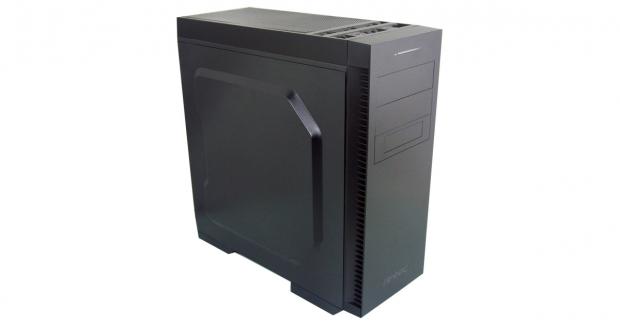The Bottom Line
Introduction, Specifications and Pricing
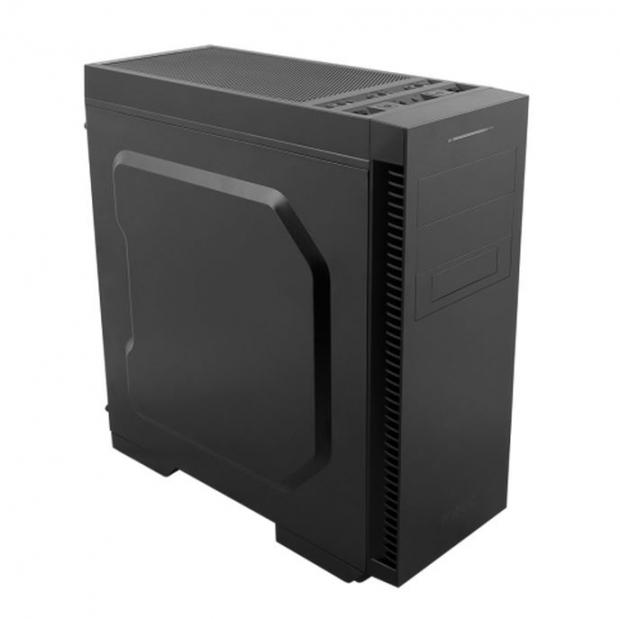
Glancing back to the Antec literature for a bit of inspiration to start this review with, we realized that is has been ten years now that the Performance series of cases have been with us. The whole idea behind this series is to offer customers with a silent chassis, but at the same time making no compromises, as well as offering a design that will allow you to grow into it as your needs progress and list of components grows larger as time goes on. With what we have seen in the past with the Antec Performance series, this series offers very wallet friendly pricing as well.
The main idea that Antec had with this chassis was to offer users a chassis that is silent, above all other design aspects. Things like redirecting sound to the sides of the front bezel, offering solid doors, and even an additional insert for the top of the chassis so that you can close that off if desired is all built right in. Along with that, they also gave the bays a refresh of sorts, and rather than a huge wall of bays like we have seen in a lot of Antec cases, this time things are more up to date with what is offered and how it is arranged. As far as the "no compromises" or the "room to grow" aspects, one they have hit on the head, and the other is something they seemed to have forgotten about completely.
Today, we will be looking at the P70 from the Antec Performance series of cases; a chassis that comes from the heritage of the P280 and P380, which are very refined stylish cases. The thing is with this P70, while offering a bit of what we know from the Performance series, it also pulls some of its design from the 900 of yesteryear. We are not against the styling at all, and even with its wallet friendly pricing going for it, we have found many issues with our chassis. While usually we do not come out with this so early in a review, and even the pricing will not save this design. If you want to find out why, continue ready as to why the Antec P70 should not be your next choice in cases.

As we follow the chart provided for us by Antec, we can skip past the P70 naming and UPC code right into the dimensions. There we are told this chassis is 18" deep, it is 8.1" wide, and it stands 18.7" in height. We then are shown that this chassis supports 380mm video cards, and offers water cooling grommets. Next, we see that there is a single USB 2.0 port and a single USB 3.0 port, along with the HD Audio jacks, long before they tell us that this is a mid-tower chassis.
We then see that the chassis includes a pair of 120mm fans, it includes a single 120mm fan in the back, and that it has room for a pair of 120mm fans in the front, but those locations are currently empty. We then are shown that there are two 5.25" bays, both with removable covers in the bezel, and the third bay down is made for 3.5" external device usage. There is room for four 3.5" drives, and what they call a dedicated 2.5" drive mount is actually two holes in the HDD rack to hang one side of the drive off of. Concluding the list of specifications, we then see there is a washable dust filter in the front with no mention of the one under the chassis. We also see the motherboard compatibility, that it offers an access hole in the motherboard tray, that it comes in black, and lastly that there are seven expansion slots.
As we look around to try to obtain this chassis, we are finding it near everywhere we look, which is a good thing. What we are seeing along with the availability is that this chassis started with an MSRP of $69.99, and from what we have seen that is a bit overpriced. If you tend to shop at Newegg, you can shave $10 off that pricing, but you will have to pay $4 of it for shipping. If you want the best deal we could find, we suggest you use Amazon, as there we found the P70 listed at $54 and no additional cost to ship it. However, in the grand scheme of things, we feel that even at a around $54 to your door, there are better options out there.
Packaging
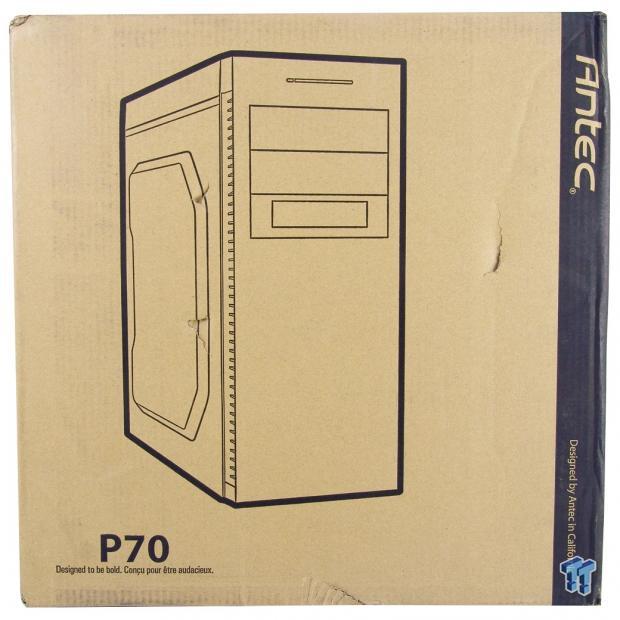
Using black printing on plain cardboard, we find a large image of the P70 taking up most of the front panel. Below is the chassis naming and the line "designed to be bold", while the right black stripe carries the company name and that these are designed in California.
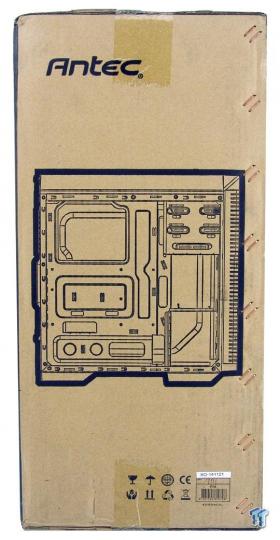
The right side of the packaging starts off with the Antec name, and aside from that, all they show is the rendering of the inside of the P70.
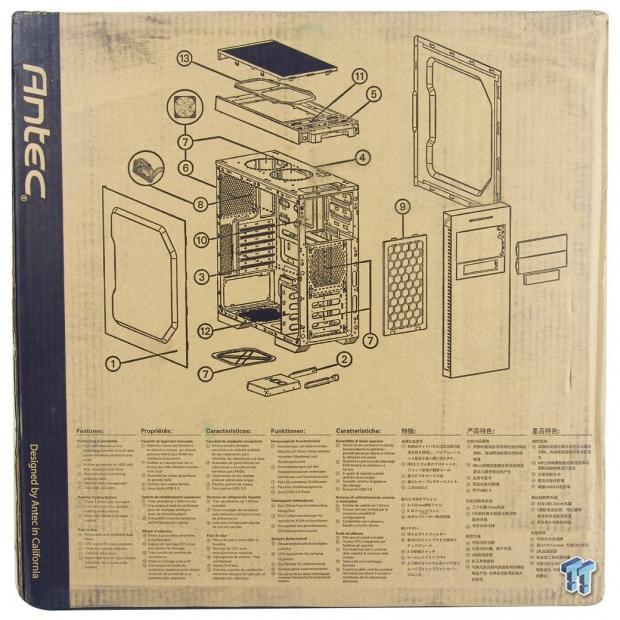
The back of the box is where the details are really shown to the customer. There is an exploded diagram of the chassis at the top with bits marked one through 13. Below the rendering, there are columns of descriptions of said bits, repeated in eight languages in total.
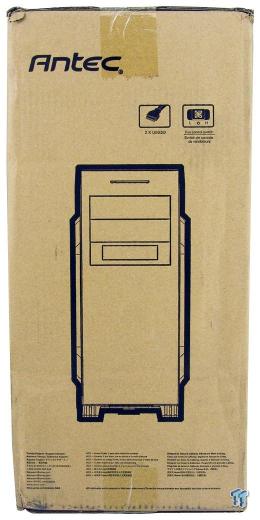
The last panel shows us that there are two USB 3.0 ports in this chassis, unlike what the chart shows, and that there are fan controls built in. Under that, we find a rendering of the front of the P70 with company information listed in the fine print below.
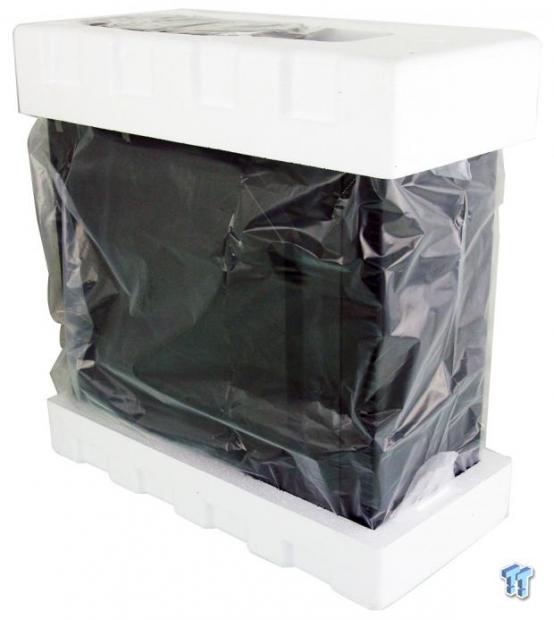
Inside of the box, we find the P70 is wrapped in a plastic liner before it gets the thick Styrofoam end caps placed on the top and bottom. Two things to note: there is a noise cover taped into the top Styrofoam cap, and that the box nor the interior packaging showed no real signs of serious damage, but the chassis we received is not in great shape at all.
Antec P70 Mid-Tower Chassis
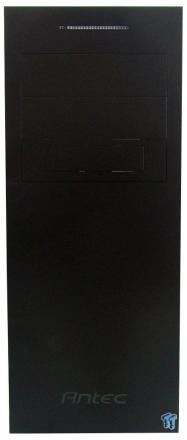
The front of the P70 would appear to have an LED backlit strip at the top, but that is not the case. Below that, we find two 5.25" covers and a 3.5" bay cover, while the rest of the panel is flat all the way down where we find the Antec name painted on in grey.
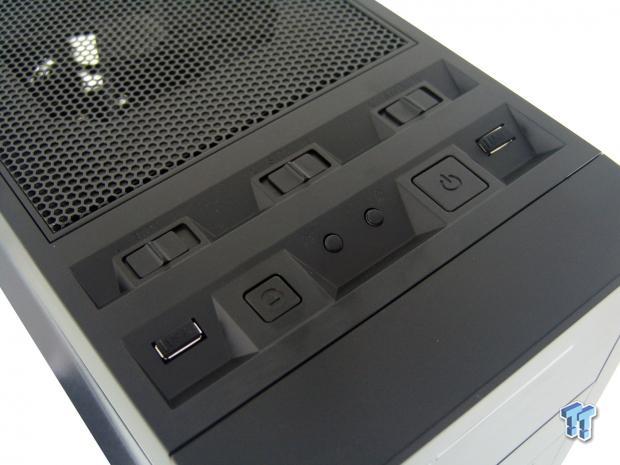
Just behind the front bezel is the overly large and chunky front I/O panel. There is a trio of fan control switches running in the back, while the front offers a rest and power button on the raised sections, and USB and HD Audio connectivity in the lower sections, but we are pleased to see rubber dust covers on them all.
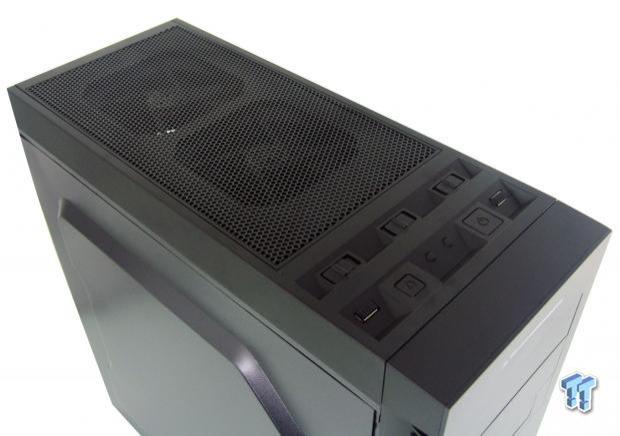
Stepping back, we see that the majority of the top panel is taken up with this very bent steel mesh panel. This is open enough to let the top fans breathe easily enough, and is also where the noise suppressor snaps into place if desired.
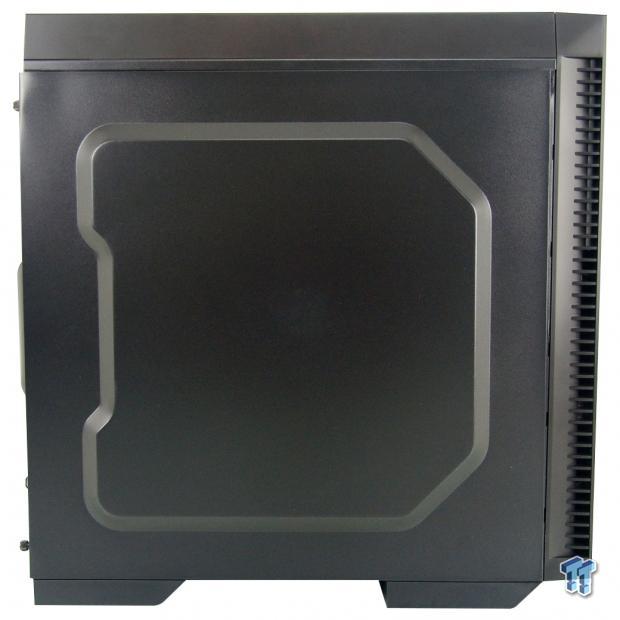
As we look at the left side of the chassis, we find that the front bezel offers ventilation on the sides, and the removable panel has a bump out in it to allow for wiring and suck behind it. We can also see the bends continue as you glance at the upper left corner of this panel.

The back of the chassis starts with a latch to remove the mesh top section, and then offers the rear I/O, water cooling grommets, and the rear exhaust location. the expansion slots have break away covers, and the PSU mounts at the bottom.
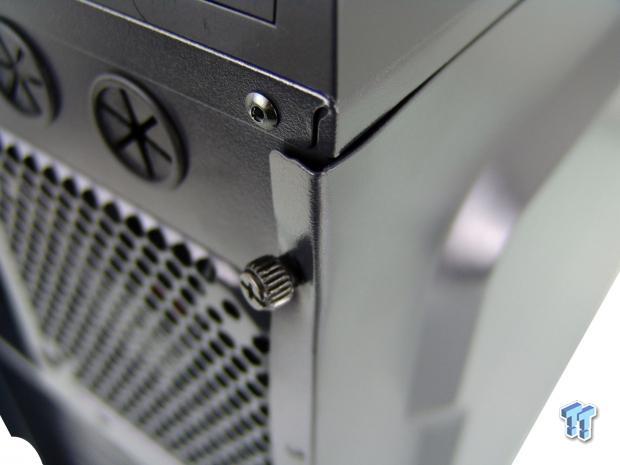
Just to prove the damage to the panel was not from shipping, we took this image. Someone on the line was lazy, and when the panel did not fit, they said "screw it!" or something along those lines and sent the screw in regardless, bending the panel in the process.
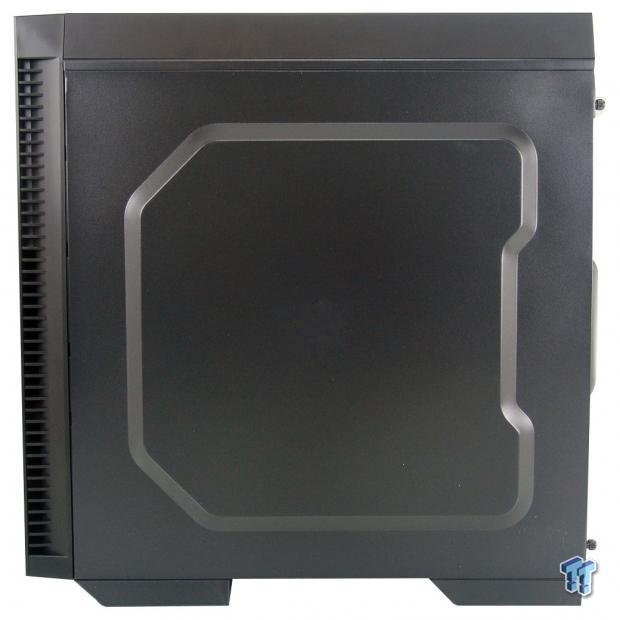
The right side of the chassis is identical to the left, just in reverse. There is ventilation at the front of the chassis, and we are given the same bump out, again to offer room for wiring. The thing is though, looking at the top right corner this time, we see this panel is bent as well, just not as bad this time.
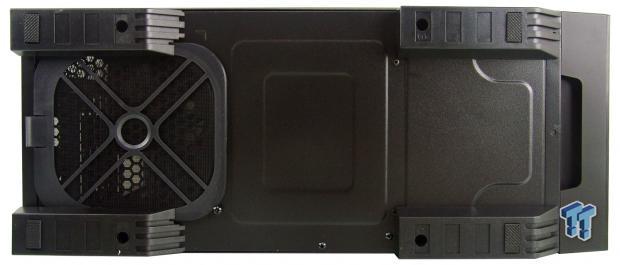
Under the chassis, we find very large feet used mostly for style since they rest solely on the tiny rubber pads under each foot. The rest of the bottom is solid steel except for where the PSU installs, and with large mesh there, and the dust filter in place, the PSU should breathe well and the short filter pulls out the back for easy cleaning.
Inside the P70

Sorry to be this blunt, but the first look inside of this chassis just screams cheaply built. The wiring is left flopping around and we do find hardware in the HDD rack, but it too is allowed to flop around in transit.
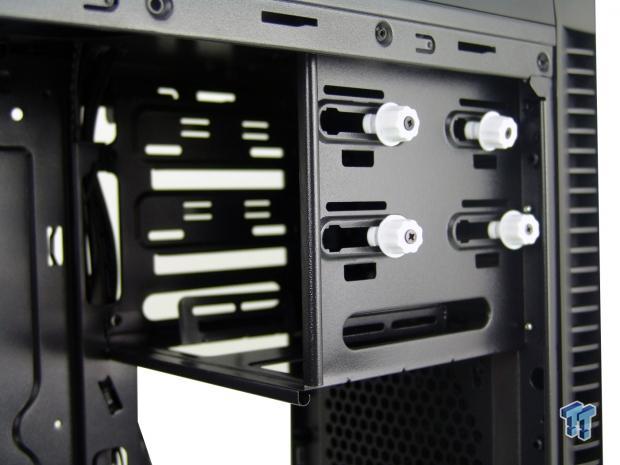
We can see that the 5.25" bays use these spring loaded screws to mount devices on this side, and require regular screws on the back to secure your devices. What it harder to see is that the 3.5" adapter sections inside are bent up, but not correctly enough to fit a device in without having to re-bend them to suit such a device.
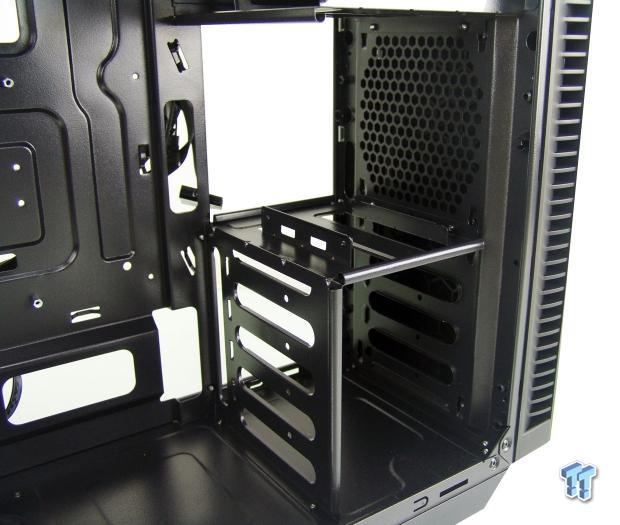
The lower section in the front of the chassis offers this HDD rack riveted into the floor of the chassis. This will hold four 3.5" drives, it has a dedicated SDD placement on top, and when looking at product images, they also mount one with the screw holes in the side of the drive cage.
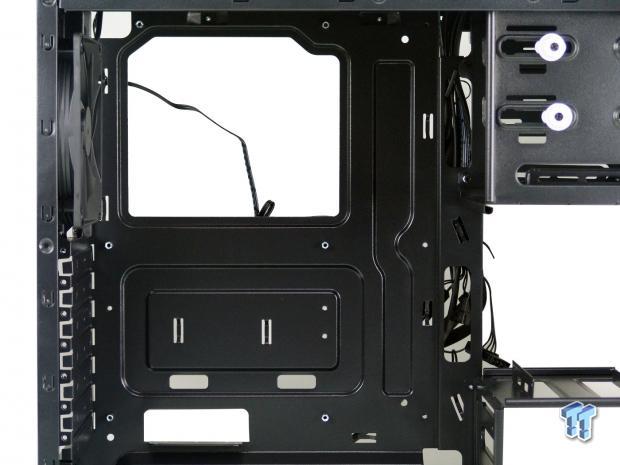
The motherboard tray will house an ATX, Micro-ATX, or a Mini-ITX motherboard, and it does offer a large access hole. There are seven holes for wiring around it, none of which have grommets, and tie points are also limited in this design.
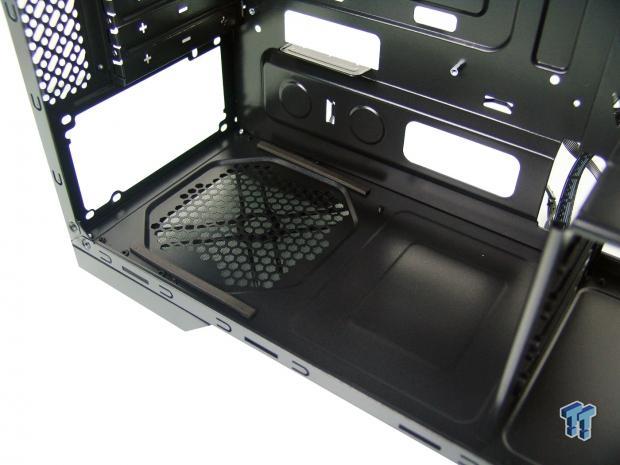
The PSU sits on two strips of foam stuck to the bottom of the chassis and offers a large hole very near the PSU, and another further forward to help with wiring since space is limited behind the tray.
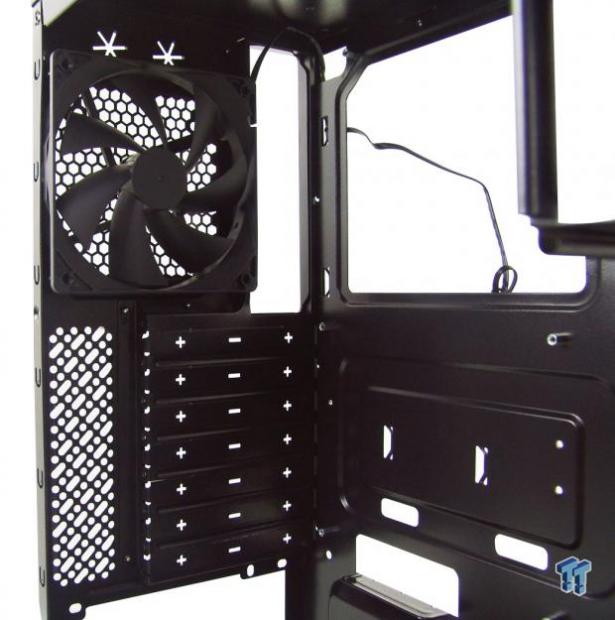
One of the three fans that come with the chassis is this 120mm fan at the back. It is pre-wired to one of the controllers, which is nice, but this is 2015 already, and we are still getting break out expansions slot covers?
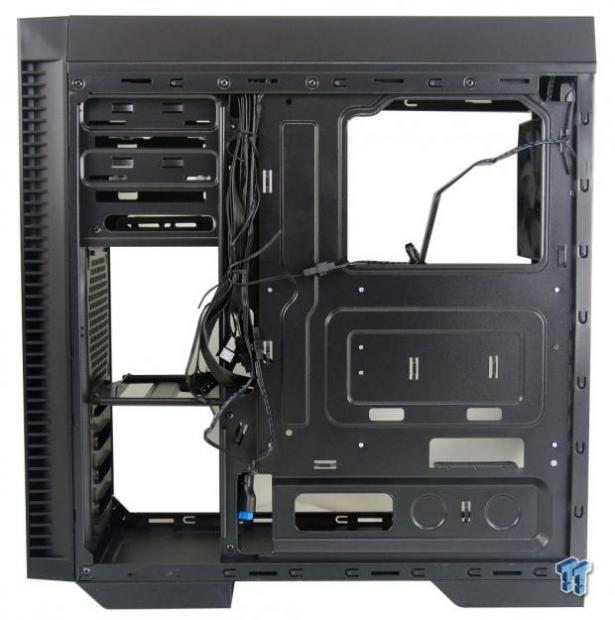
Behind the motherboard tray, there is very little room for wiring, except the small area at the bottom where the PSU is installed. There is more room to the left obviously, but without a full set of bays, anything ran there will be easily seen when the door panel is off.
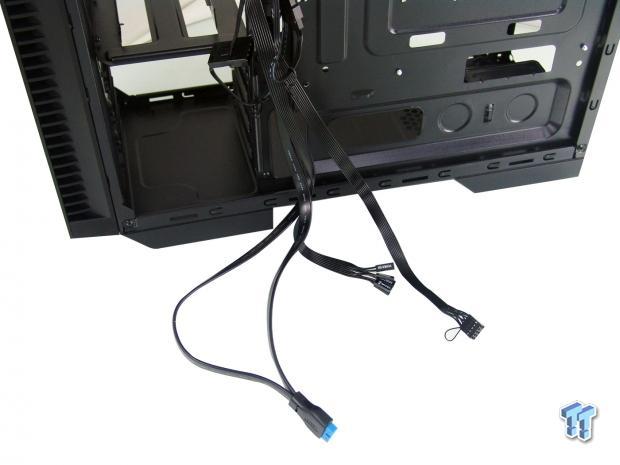
Along with all of the fan controller leads and the Molex plug to power all three, there is also the native USB 3.0 connection, the button and lighting wires, and the HD Audio cable, all done in black, and plenty long enough to get where they need to be.
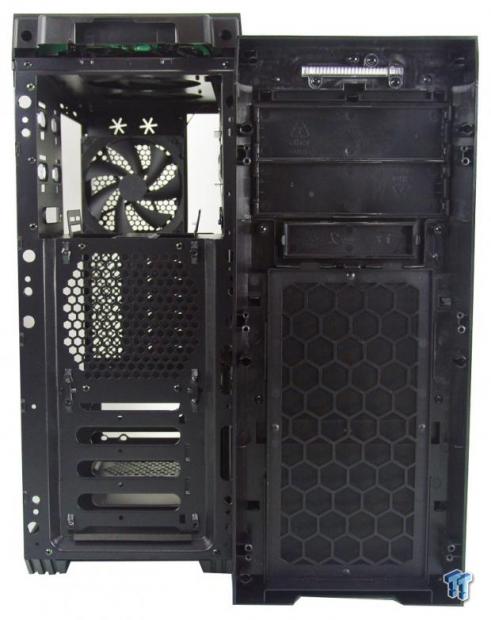
Removing the front bezel, we find two things: one of course is that the fans mount here rather than inside of the chassis, which is not a big deal. The second part we find is that the top of the chassis offers no LED to back the clear strip at the top of the bezel.
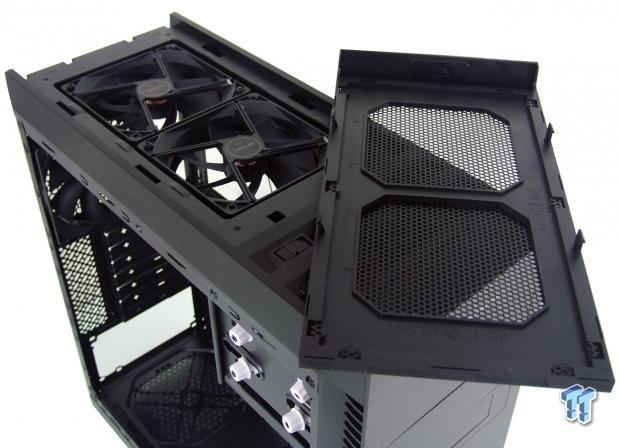
Unlocking the latch at the back allows the mesh cover to slide out the back and then be lifted off. Under this, we find there are the second and third 120mm fans included in the chassis. If you want to remove the entire top panel, just realize that the chassis wiring will have to come with it, so do it before you wire things up.
Accessories and Documentation
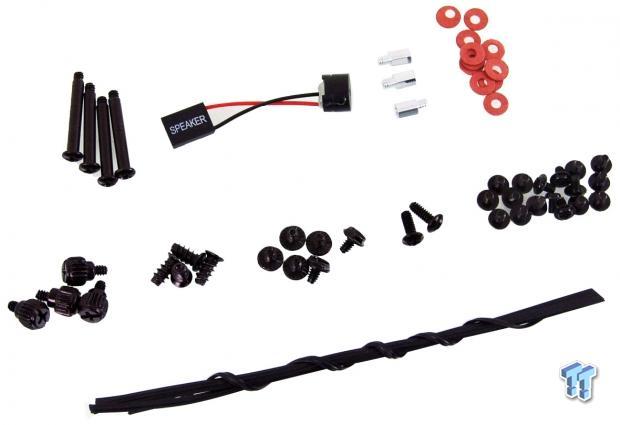
In the box of hardware, we find only four long screws for fan installation in the front of the chassis, and by our count, we need eight. There is a speaker, a few standoffs they chose not to install, and in case you like cases from 1995, there are paper insulation washers. The middle row offers up four thumbscrews to lock in the hard drives, four extra fans screws, expansion slot screws, a pair of screws we have no idea what they are for, and bunches of M3 screws for the motherboard and 2.5" drive installations. For wire management, they offer five long wire ties.
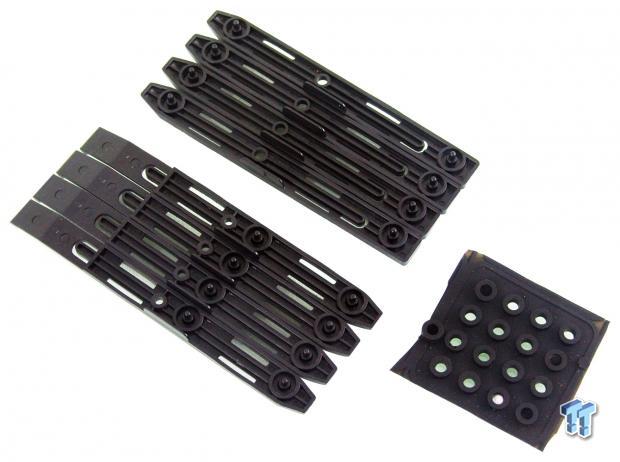
To mount the 3.5" drives, you are given a set of eight rails. They also send a sheet of rubber washers that you need to peel off the sheet and stick to the pins on the rails. This will keep things from rattling around and take the slop out of them.
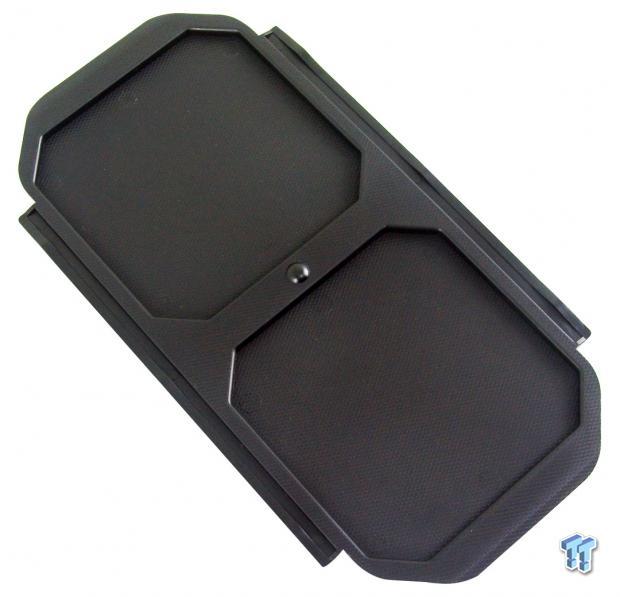
The part that was shipped in the Styrofoam top cap is what we are seeing here. For those who choose to move the top fans or remove them all together, this plastic plate then clips into the mesh top panel to keep noises from making their way out of the top of the P70.
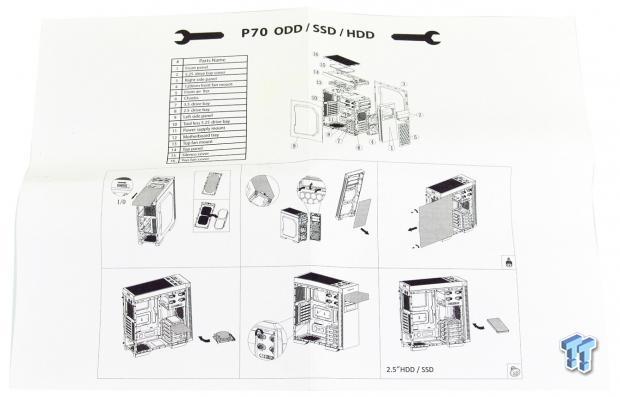
If you get confused during the build, good luck finding a solution, as this is the extent of the guide to help you with the process. We get the same thing from the back of the box, and a six step process of images only to attempt to get the build completed.
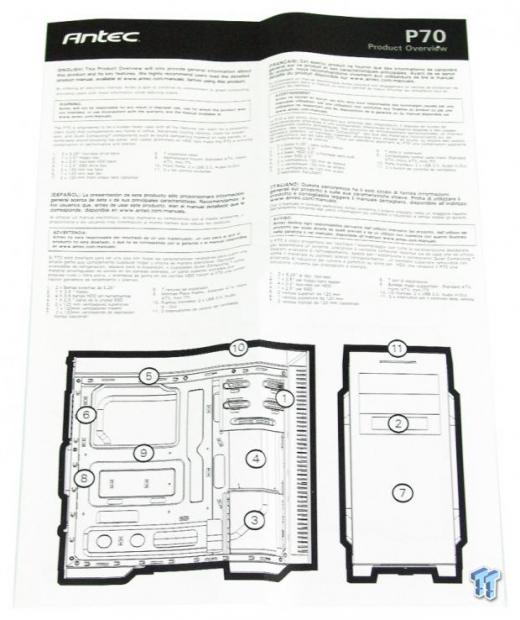
Just in case you were not sure what the bits in the layout were for, Antec is sure to give this to you a third time rather than working on a better guide or a chassis that isn't bent about everywhere we look at it.

We do like that if they are going to send out damaged products from the factory, at least they are sure to send along the information for the two-year warranty. In our instance, this would be very handy to have as we would be returning this chassis as soon as the foam and plastic came off the case had we paid for it.
Case Build and Finished Product
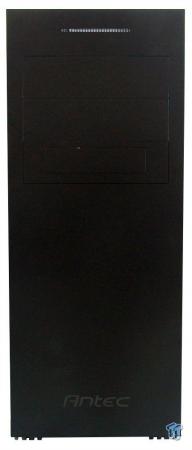
As expected, and since we do not use an optical drive in our test system, at least the front of the chassis keeps the sleek black look it offered out of the box.
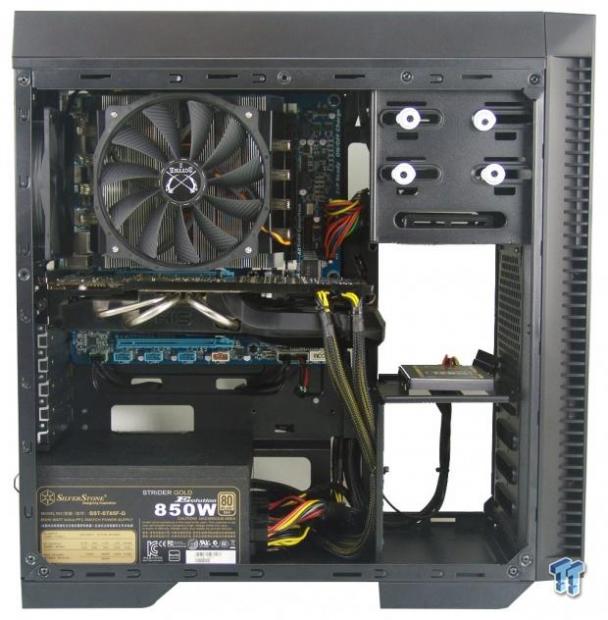
When installing the motherboard, we found two of the standoffs were already stripped for our pleasure, the back of the chassis needs to be forced in for the video card, and the threads are not cut for the screws that hold it in place. As for the PSU and SSD, we didn't run into issues with those at least.
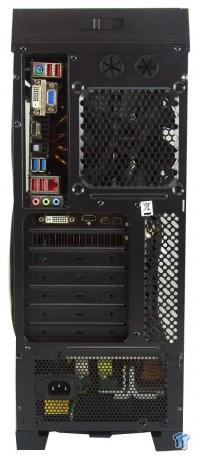
Out back everything is normal. The rear I/O lines up, we did manage to get the video card in with a bit of effort, and the PSU fills the large hole at the bottom.
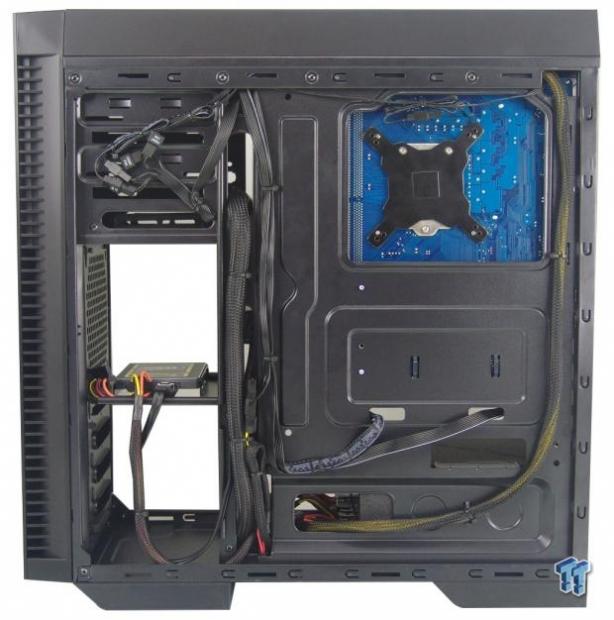
While there is a bump to help allow the 24-pin, GPU, SATA, and front panel wiring, the part they forgot about was the 8-pin run. Even with just the one wire there, we had to force the panel back on as there is not enough room offered for that.
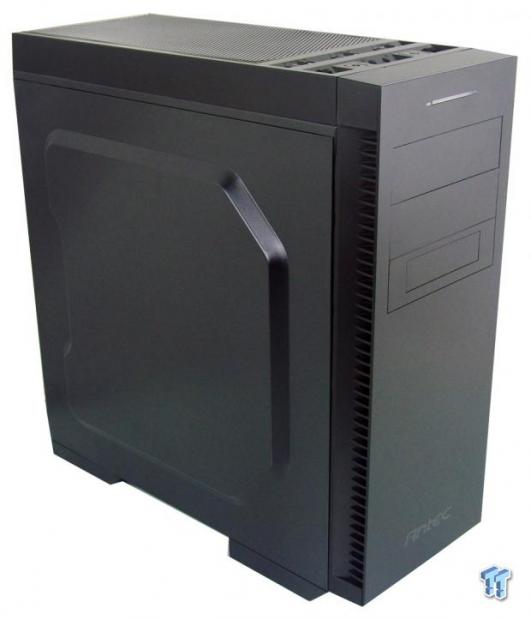
With everything buttoned up and ready for the power testing, without a window to view the hardware inside, not one thing about this chassis design changes. What you see out of the box is what you get when the build is completed.

Once we put power to the PSU and powered things up, there was no lighting coming through the front of the chassis, and there is not one LED in the front I/O panel either. While some may like it this way, easily finding things in the I/O becomes a feeling game. If not for the 32 dB of noise we heard from the back of the chassis, we would have had to open the P70 to even tell it was running. So, at least, it got the quiet part right.
Final Thoughts
Antec's Performance Series P70 is one of those cases where the price will attract you to it, and on paper, it seems like it should have everything you need in a mid-tower design. Of course, the mix of the old 900 with the Performance series brethren is attractive, and this chassis would be good for gaming or even as an HTPC, as it will blend into the background and not be very flashy in that environment.
The bumps on the sides do help some, but as we discussed, they aren't without issues. The fan controls are nice to have, and we like that they at least offer dust covers for the connectivity ports that face upwards and would otherwise fill with dust over time. We also like the option to close off the top of the chassis, but we honestly would rather have the fans in the front and a solid top panel if the one we are going to get is all bent up and funky to look at.
For everything we sort of liked, there seemed to be an equal or worse thing about this case that puts us off. First off is the plain lack of quality control. While companies want us to email them and report damages so they can send us a better case, why should we do that when it is then the customers who are the only ones getting screwed? The box does not show the damage needed to bend the side panel, and there is nothing inside that would bend the 3.5" drive rails out of alignment; it all boils down to lazy or fed up employees in the factory, all the way from the person smashing steel sending screws in, and to the person at the end of the line that passed this chassis and allowed it to be boxed.
The reality is, even for this price, it seems like we took a timewarp back 10 or 15 years in the past when cases were just a box to hold your goods, and people were more accepting of imperfections. The problem is, in today's market, if you fail to produce quality goods, there are only say 20 or 30 other newer companies more than willing to take your customers away from you.
Of course, this all just may be bias since we are seeing so many amazing cases lately, but the lack of attention to detail and the fact that this is happening in house and not on the road makes it so much worse in our opinion. One look at the box and we thought we were good to go, but after opening things and taking a close look around, there is just too much thoughtlessness to be accepted. Even though, if you shop around for the best deal, and grab this chassis for $54, we still feel you are paying too much.
Considering this chassis released with an MSRP of $69.99 is almost laughable at this point. We feel you will want to look past the Antec P70 mid-tower chassis and find a wiser solution to spend your hard earned money on.

